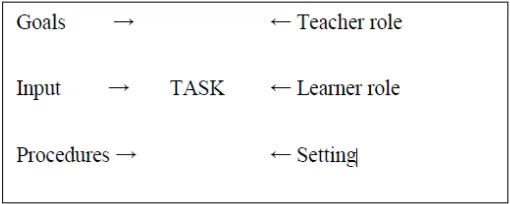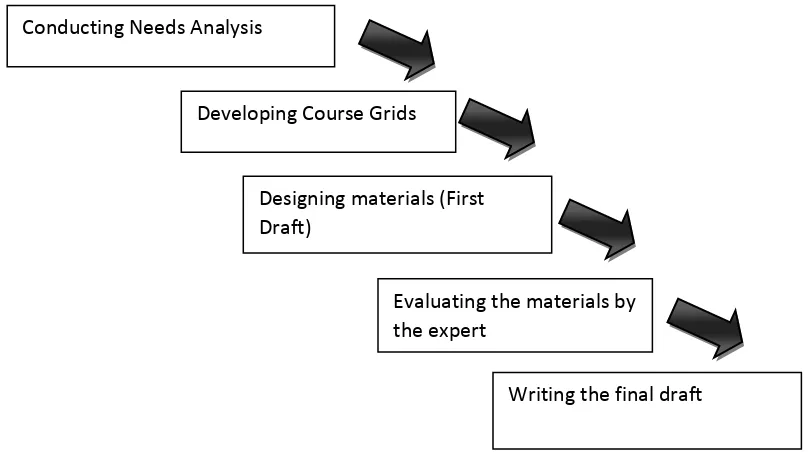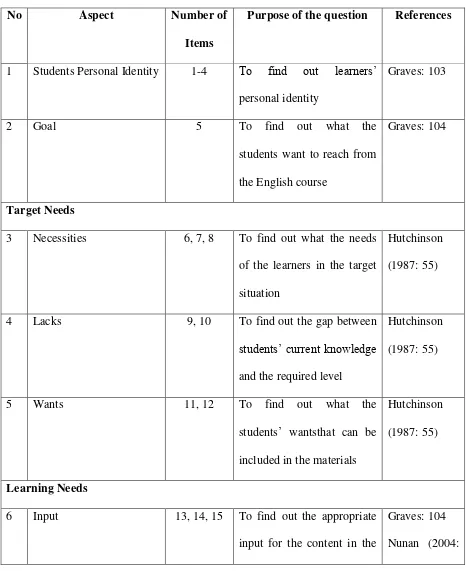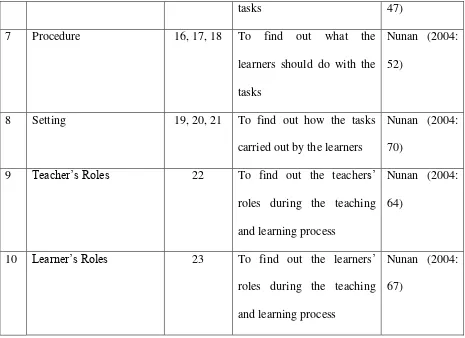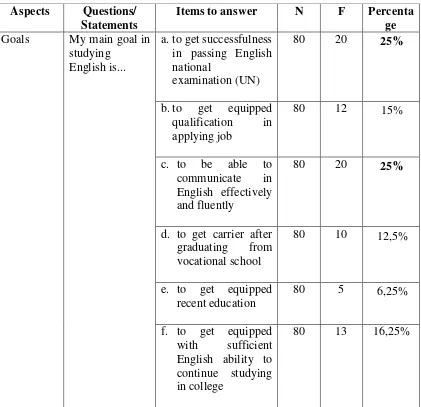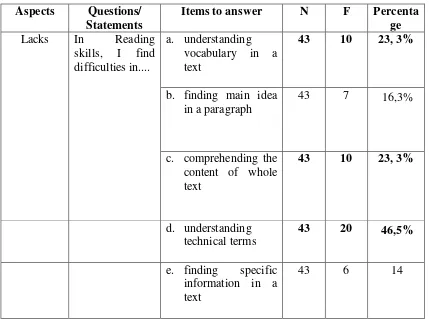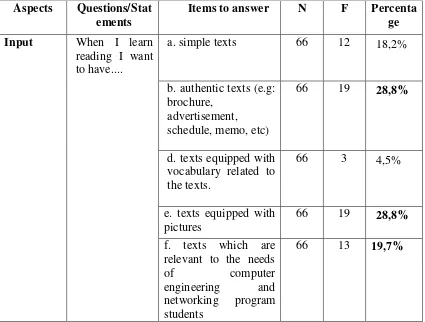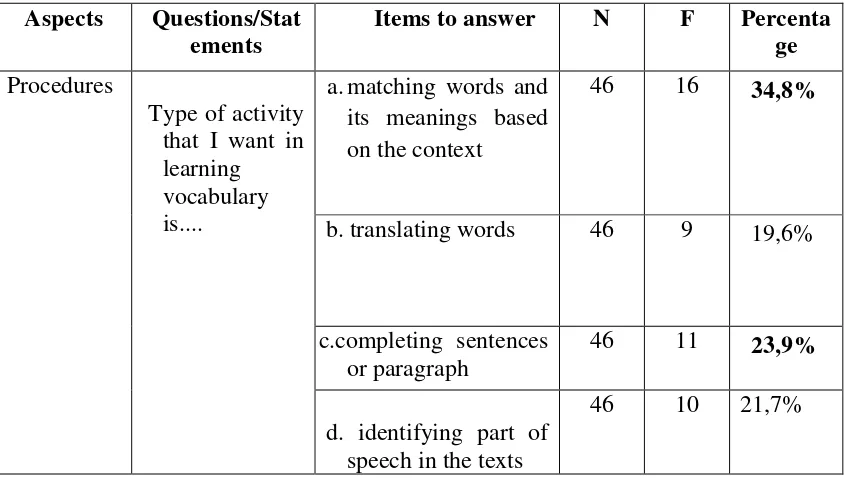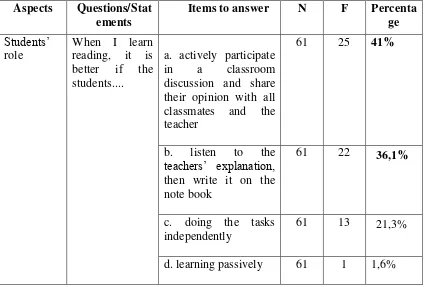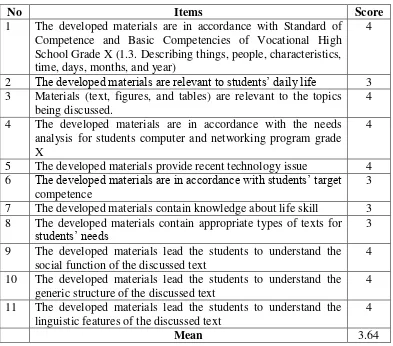STUDENTS OF COMPUTER ENGINEERING AND NETWORKING PROGRAM AT SMKN 1 PUNDONG IN THE ACADEMIC YEAR OF 2014/2015
A THESIS
Presented as partial fulfilment of the requirements for the attainment of the Sarjana Pendidikan Degree on the English Education
Erna Dwi Jayanti
11202241058
ENGLISH EDUCATION DEPARTMENT
FACULTY OF LANGUAGES AND ARTS
YOGYAKARTA STATE UNIVERSITY
v
MOTTOS
Allah never changes the condition of a people unless they strive to change themselves (Holy Quran Surah Ar-Ra’d:11)
Where there’s life there’s hope – J.R.R Tolkien
A lesson without pain is meaningless. – Edward Elric
We have to break through the limits. It’s better than regretting it, isn’t it? –
vi
vii
ACKNOWLEDGEMENTS
All praises may be sent to Allah swt. the Most Gracious and the Most Merciful. Because of Allah’s blessings, finally I could finish my study and thesis. I would like to address my gratitude to the people who have supported me in finishing my thesis.
Firstly, my deepest gratitude goes to my supervisor, Dra. Jamilah, M.Pd. for all her patience, motivations, and suggestions during the process of writing this thesis. I also express my gratitude to all lecturers of English Education Department who taught me a lot of things during my study.
Secondly, I would like to deliver my gratitude to the headmaster of SMKN 1 Pundong, the English teachers, and the students of Computer Engineering and Networking program grade X-A for helping me to conduct the needs analysis.
My gratitude is also conveyed to my father and mother who are never tired to pray and encourage me to finish my study. My big thank is sent to my sister, the one with whom I could share any problems.
In addition, I would thank my friends in PBI 2011: Aulia, Ismi, Bety, Dite, Nindya, Christy, Nisa, Anin, Rekyan, Lathif, Aji, Slamet, Erika, Astika, Imron, Danar, Karisa, Dika, Siwi, Eva, and Nining. Thank you for giving me a true meaning of friendship.
Finally, I realize that this thesis is not perfect. Therefore, suggestions and comments for improvement of this thesis are highly approved. I hope this thesis will be useful for teachers at vocational high schools and other materials developers, especially who conduct the similar topic.
Yogyakarta, October 8, 2015
ix
TABLE OF CONTENTS
Title ... i
Approval Sheet ... ii
Ratification Sheet ... iii
Declaration ... iv
Mottos ... v
Dedications ... vi
Acknowledgements ... vii
Table of Contents ... ix
List of Tables... xiii
List of Appendices ... xv List of Figures ... xvi
Abstract ... xvii Chapter I: Introduction A. Background of the Problem...1
B. Identification of the Problem ...3
C. Limitation of the Problem ...5
D. Formulation of the Problem ...5
E. Objectives... 6
x
Chapter II: Literature Review and Conceptual Framework
A. Literature Review ………...8
1. English Teaching and Learning at Vocational High School... 8
2. English for Specific Purposes (ESP)...11
a. Definition of ESP...12
b. Needs Analysis ...12
c. Materials Development in ESP...15
3. Content Based-Instruction (CBI)...17
a. Definition and Principles of CBI... 17
b. Theory of Language...21
c. CBI Models...22
d. Theme-based Instruction...23
e. Types of learning and teaching activities...25
f. Learners and Teachers Role in CBI...26
g. Roles of Materials...27
4. Reading Theory...27
a. Reading Learning Principles ...28
b. Micro- and Macro-skills of Reading………...…..29
5. Materials Development...………... 31
a. Definition of Learning Materials……….... 31
b. Criteria of Good Materials... 33
c. Definition of Materials Development... 34
d. The Model and Materials Design... 35
6. Unit Development………..………...38
a. Models of Unit Development ...38
xi
7. Tasks Development…………..……..………...41
a. Definition of Tasks...41
b. Tasks Grading and Sequences………...42
c. Tasks Components………...43
8. Materials Evaluation...45
B. Relevant Research Studies………...………... 46
C. Conceptual Framework………...………...47
Chapter III: Research Method A. Type of Research Study………... 49
B. Setting of the Research………...49
C. Research Procedure………...50
D. Data Collection Technique………... 52
E. Data Analysis Techniques………...56
Chapter IV: Research Findings and Discussions A. Research Findings………...58
1. The Results of Needs Analysis………... 58
2. Course Grids………... 74
3. The Unit Design………...76
4. The First Draft of Materials………... 78
5. Expert Judgement………...80
B. Discussion………... 102
C. Limitation of the Products………...104
Chapter V: Conclusions and Suggestions A. Conclusions………...105
a. Target Needs ………..105
b. Learning Needs………...106
xii
B. Suggestions………...108
xiii
LIST OF TABLES
Table 2.1. Standard of Competence and Basic Competence ... 9
Table 3.1 The Organization of First Questionnaire ... 53
Table 3.2 The Organization of Second Questionnaire ... 54
Table 3.3 Data Conversion Table ... 57
Table 4.1 Description of the Respondents ... 59
Table 4.2 Students’ Goals ... 60
Table 4.3 Students’ Necessities in learning English ... 61
Table 4.4 Students’ Proficiency Level ... 62
Table 4.5 Students’ Lacks in Reading Skills ... 63
Table 4.6 Students’ Wants in Reading Skills ... 64
Table 4.7 Input of Reading materials ... 65
Table 4.8 Pictures Availability ... 66
Table 4.9 Reading Input ... 66
Table 4.10 Length of Texts ... 67
Table 4.11 Reading types of activity... 68
Table 4.12 Types of activity related to Grammar ... 69
Table 4.13 Types of Activity related to Vocabulary ... 69
Table 4.14 Settings ... 70
Table 4.15 Numbers of Tasks ... 71
Table 4.16 Settings ... 71
Table 4.17 Teachers’ Roles ... 72
Table 4.18 Students’ Roles ... 73
Table 4.1 9 The Content Appropriateness of Unit 1 ... 81
Table 4.20 The Appropriateness of the Presentation of Unit 1 ... 82
Table 4.21 The Appropriateness of the Language ... 83
Table 4.22 The Appropriateness of the Layout Unit 1 ... 84
Table 4.23 The Revision of Unit 1 ... 85
Table 4.24 The Content Appropriateness of Unit 2 ... 89
Table 4.25 The Appropriateness of the Presentation of Unit 2 ... 90
Table 4.26 The Appropriateness of the Language of Unit 2 ... 91
xiv
Table 4.28 The Revision of Unit 2 ... 93
Table 4.29 The Content Appropriateness of unit 3 ... 95
Table 4.30 The Appropriateness of the Presentation of Unit 3 ... 96
Table 4.31 The Appropriateness of the Language of Unit 3 ... 97
Table 4.32 The Appropriateness of the Layout Unit 3 ... 98
xv
LIST OF APPENDICES
APPENDIX A. The needs analysis instrument...114
APPENDIX B. The needs analysis data...119
APPENDIX C. Course Grid...127
APPENDIX D. The description of the tasks...133
APPENDIX E. The first draft of the materials...146
APPENDIX F. The expert judgement questionnaire...206
APPENDIX G. The expert judgement data...222
APPENDIX H. Revisions of the units...228
APPENDIX I. The final draft of the materials...234
xvi
LIST OF FIGURES
Figure 2.1 Jolly and Bolitho’s Material Development Process ... 35
Figure 2.2 Task Components ………... 43
Figure 3.1 Procedure of the Research ... 50
Figure 4.1 Course Grids Design ... 75
xvii
DEVELOPING READING LEARNING MATERIALS FOR THE GRADE X STUDENTS OF COMPUTER ENGINEERING AND NETWORKING
PROGRAM AT SMKN 1 PUNDONG IN THE ACADEMIC YEAR OF 2014/205
By: Erna Dwi Jayanti
11202241058
ABSTRACT
The objectives of this research are: (1) to describe the target needs of the grade X students of Computer Engineering and Networking department at SMKN 1 Pundong; (2) to describe the learning needs of the students grade X of Computer Engineering and Networking department grade X of SMKN 1 Pundong; and (3) to develop appropriate reading materials for year X students of Computer Engineering and Networking department of SMKN 1 Pundong.
This study is categorized as Research and Development (R&D) study. The subjects of this research were the students of Computer Engineering and Networking department grade X of SMKN 1 Pundong. This study is adapted the R&D model proposed by Jolly & Bolitho in Tomlinson (1998). The steps of this study were conducting needs analysis, developing the course grid, developing the first draft of the materials. Two types of questionnaires were used to collect the data. The first questionnaire was made to obtain the data for the needs analysis which was distributed to the students of Computer Engineering and Networking department grade X-A of SMKN 1 Pundong. The second questionnaire was used to obtain the data about the appropriateness of the materials by distributing to an expert. The data for both questionnaires were analyzed quantitatively through descriptive statistics.
1
INTRODUCTION
A. Background of the Study
English has become one of the tools to connect people in communicating with each other as it is the international language that covers almost all of aspects in people’s life, such as in education and professional working. In education, we
could see that any levels of education in Indonesia requires English as one of the subjects taught in school, from elementary to college level and even it becomes one of the subjects examined in national examination. In working field, many people learn English to communicate actively and to fulfil competence demanded by companies or some certain jobs. Learning English is important, especially for those who are going to face the real working field right after graduating from schools, in this case is, vocational high school students.
English in order to support their career, one of them is by providing good materials.
Materials are parts of the English teaching and learning that make the vocational school students become more familiar with English along with the relevant field they study. Reading materials as one of the parts in English learning materialsare considered essential since they can help students to get more exposure in English as well as learn something new about their discipline. Through reading, the students can learn English as a language and they can also expand information about the rapid development of technology presented in English. By having a good proficiency in reading skills, they probably can know something new they have never known before and build the curiousity of certain terms or vocabulary related their subject study. They will not see English simply as a subject they must go through during the school, yet they will consider English as something they have to learn in order to support their better career and future. The students are at least expectedto knowcomputer engineering and networking terms in English that they will find later on once they face the real working field, such as understanding manuals, knowing instructions in computer and networking domain, being familiar with components of computer and networking, and so on.
However, in the real teaching and learning process vocational school students do not get much exposure in learning English since the provided material does not really fulfil students’ needs, especially the reading materials. The reading
to learn English as well as learn about computer engineering and networking as their field.
B. Identification of the Problem
According to the researcher’s observation at Computer Engineering and Networking department at SMKN 1 Pundong, there are several problems that cause English teaching and learning process being ineffective. Students in the schools still lack of Reading skills because they do not have much intention to read English texts although in fact reading is one of the keys to get much exposure that can improve their English ability.
One of the important things that can make English teaching and learning become effective is materials. Appropriate materials refer to the materials that meet the need of students, particularly vocational high school students who have different goals with other regular high school students. Materials will give a direct impact to the teaching and learning process since the students can relate what they learn in English to the real world they are facing. Through the materials, students are also expected to pay more attention to English subject and realize the advantages of reading for their lives.
same as what are used by regular high school eventough their needs are far different.The existing materials in the markets also do not fulfil their needs since they only learn general English from the books used by the teachers. It causes the students’ intention to read the texts on the books low, since they do not find any
relevancy on what they learn and what they actually need.
Moreover, the books distributed recently that are based on Curriculum 2013 also do not solve the problem. Instead, it raises anxiety for students, teachers, and school. The new regulation of Education Ministry even gives more impacts that cause hesitation. It is getting complicated since the changing of curriculum from Curriculum 2013 to School-based Curriculum (KTSP) at the schools makes the students and also the teachers feel confused.
Teachers who have already known this situation are expected to design materials that are relevant to the students’ needs, but since their limitation of time,
energy, and lack of understanding on how to design materials for specific field, it is almost impossible for them to design such materials. It is time-consuming to conduct needs analysis, match the related topics to syllabus, and evaluate the materials, while as we know teachers have so many things to do to carry out their duty as educators. Those become the reasons why the available materials provided by the markets whose contents do not really fit to students’ needs are more likely
to use.
needs a lot of things to consider. The available materials are actually not bad, but they just do not meet students actual needs and it is even hard to find specific English materials to use for Computer Engineering and Networking students.
Based on the stated problems, the researcher tries to carry out a study which is expected to produce Reading materials that can facilitate students majoring Computer Engineering and Networking in learning English. Throughout the reading materials, students are supposed to learn English in an enjoyable way and take reading activities into account that can change their English ability in a good way.
C. Limitation of the Problem
Since it is impossible to overcome all of the problems, the researcher tries to limit the problem into more specific aspect. The focus of this research is to developappropriate Reading materials that can make students motivated to learn English. The materials will be for Computer Engineering and Networking students grade X semester 2 and will be designed based on the Standard ofCompetence and the Basic of Competence of English skills from the School-based Curriculum.
D. Formulation of the Problem
1. What are the target needs of the tenth grade students of Computer Engineering and Networking department at SMKN 1 Pundong?
2. What are the learning needs of the tenth grade students of Computer Engineering and Networking department at SMKN 1 Pundong?
3. What are the appropriate reading materials for the tenth grade students of Computer Engineering and Networking department at SMKN 1 Pundong?
E. Objective of the Research
According to the problems that have been mentioned, the objectives of the research are to find out the target needs and the learning needs of the grade X students at Computer Engineering and Networking program and to design appropriate Reading materials for them.
F. Significance of the Research
The research is expected to give a meaningful contribution to some parties:
b. For the students, it helps them to be more motivated in learning English and get more exposure particularly in reading skills that can help them in understanding English dealing with their major.
c. For other researchers, this research can be a reference for them who are willing to make materials with the same topic,
8
This chapter focuses the base theory of this study and the conceptual framework. The theories deal with the description of English taught at vocational high school majoring computer engineering and networking, the use of ESP approach to develop materials, the method called CBI, materials development, unit development and task-based language teaching approach. In the end of the chapter, all the theories are put into the conceptual framework as the overview to guide the flow of this research.
A. Literature Review
1. English Teaching and Learning at Vocational High School
Teaching and learning English at vocational schools cannot be separated from the curriculum as the guide to conduct a subject. Since 2013, the government has been implementing a new curriculum called Curriculum 2013 to change the previous curriculum, School-based Curriculum (KTSP). During the implementation, Curriculum 2013 raised controversion since some parties such as students, teachers, and schools did not really understand what the curriculum means, espesially in language teaching and learning. There are some pro and con of the curriculum. Some said it can stimulate students’ critical skills, but others
the confusion arised in the Indonesia education, the new Education Ministry made a decision that is applied in 2014/2015 academic year. Schools that are considered to be ready to apply Curriculum 2013 are permitted to continue using the curriculum, while schools that are not ready enough can change back to KTSP.
The curriculum of vocational high schools in KTSP and Curriculum 2013 is quiet different. The base of KTSP curriculum is stated in the Governments’ Regulation (No.19/2005) by Badan Standar Nasional Pendidikan (BSNP) which states the use ofthe Standard of Content in the Governments’ Regulation (No.22/2006). In the Standard of Content, vocational school competencies include three levels: novice, elementary, and intermediate, while in Curriculum 2013 all competencies in regular high school and vocational school are simply the same. In this study, the researcher is trying to use KTSP as the guide to develop the materials since SMKN 1 Pundong as the subject of this study employs KTSP. Because the research is conducted for X grade students, the materials are based on the standard of competencies and basic competence at novice level.
The following table presents the school-based Curriculum which is employed to develop materials in this research.
Table 2.1. Standard of Competence and Basic Competence Standard of Competence Basic Competence
Standard of Competence Basic Competence 1. Communicating in English
on the level of Novice
1.1 Understanding the basic language functions for the daily social interactions.
1.3 Describing the name of things, person, characteristics, time, days, months, and years.
1.4 Producing a simple speech or communication for the basic function.
1. 5 Explaining the continuous activity. 1. 6 Understanding the memo and simple
menu, schedule of travelling and traffic lights.
1. 7 Understanding the foreign words and terms and also simple sentences based on thedictionary.
1. 8 Writing simple invitations. 2. Communicating in English
on the level of Elementary
2.1 Understanding the simple daily conversations in the personal professional context.
2.2 Making short notes or simple messages in adirect interaction and using device.
2.3 Making the list of duties and education background in the written and spoken forms.
2.4 Telling the past and future experience.
2.5 Telling many kinds of language functions
2.6 Understanding simple instructions. 2.7 Understanding short messages,
direction and list, words and sentences that are received.
3. Communicating in English on the level of Intermediate
3.1 Understanding the monologue in a certain situation of job.
3.2 Understanding the conversations with the foreigners.
3.3 Making a report.
3.4 Understanding how to use the equipments manually.
3.5 Understanding the simple business letters.
3.6 Understanding the technical document.
English itself in vocational highs school is categorized as an adaptive subject matter which has the goal to prepare the studentsto have a good communication in both written and oral English based the context, especially the one exists in their discipline. It is important since the students have to be compentence in facing the era where technology plays a key role. They are expected to be able to compete globally since computer and networking are getting sophosticated in the modern world. As what is expected from vocational high school students, they have to be more skilful rather than students from regular high school in many ways.
After the students graduate, they have a wide opportunity to work as computer technicians, website administrators, and other professions related to IT industry. Students of computer engineering and networking program also can continue study in the higher education such as in Technology and Informatics major or Computer Science major. They have large prospects and chances to be successful, mainly in computer and networking area that always needs capable people to work in.
2. English for Specific Purposes (ESP)
networking students have different needs in learning English, the English materials also should stick to English for Specific Purposes (ESP). This section illustrates ESP as the relation of designing materials, such as the definition of ESP, need analysis, and materials development.
a. Definition of ESP
Hutchinson and Waters (1987:19) state that "ESP is an approach to language teaching in which all decisions as to content and method are based on the learner's reason for learning". ESP has characteristics in which the teaching and learning concern on how students can meet the specific needs they want to learn (Anthony, 1997:1). This is in line with Graves (2000) who proposes that ESP is illustrated as an umbrella of teaching and learning process for specific purpose. Basturkmen (2006:17) also supports the idea in which ESP is about preparing learners to use English within academic, professional, or workplace environment. In language teaching, ESP is important as Nunan (2004:7) in Basturkmen (2006:17) also declares that ‘ESP is the subcomponet of language teaching, with its own approaches to curriculum development, materials design, pedagogy, testing and research’.
b. Needs Analysis
The purposes of needs analysis are shown as follows. a. Finding out what language skills needed by the learners.
b. Knowing whether the previous course has met the students needs
c. Knowing the students who are most in need of training a certain language skills.
d. Identifying direction change that is important according to a particular group
e. Identifying a gap between what the students are able to do and what they have to be able to do, and
f. Collecting information about problem of the students (Richards, 2001:52) To identify what the needs of the ESP learners, Hutchinson & Waters (1987:55) devide two terms called target needs and learning needs. Target needs include neccesities, lacks, and wants, while learning needs cover what the learners need to do.
The first analysis should be done is target needs which are described as something will be needed by the learners in the future, especially the use of language (Hutchinson & Waters: 1987). They divide the target needs into three aspects: necessities, lacks, and wants.
a) Neccessities
computer terms, understanding computer instruction, and so on. Necessities are closely related to the situation where the learners take place (Hutchinson & Waters, 1987:55).
b) Lacks
Every learners must have problems in the English learning such as the lack of proficiency, vocabulary, grammar, and it is also very possible if one student has different problem with others. Lacks are defined as the gap occurs between the difficulties and the necessities (Hutchinson & Waters:1987). When learners cannot achieve the necessities that concern the demanded knowledge, there are lacks that become the reasons. For example, computer and networking students still are not familiar with some words related to computer that make them feel difficult when doing computer instruction.
c) Wants
designer, teachers, and other factors cannot fullfil what the learners want. Thus, the combination of necessities, lacks, and wants is important for course designer to decide the exact needs that meet the learners.
Besides conducting needs analysis through necessities, lacks, and wants to find out the learners target needs, course designers also have to know what learning needs are. Learning needs refer to what students should do to achieve the target situation. When the learners have already known what their goal of study, the difficulties they have, and other things they want to know, there is also must be a route or road to link them. Through knowing the learning needs, a course designer should consider some other aspects such as the condition of the learning situation, the existing knowledge and skills, and the motivation of learning English. Learning needs also tell which learning methods and learning materials students have to learn in order to achieve the target situation.
c. Materials Development in ESP
for teachers of ESP courses, teaching materials function as a source of language, learning support, for motivation and stimulation, and for reference.
Hutchinson & Waters (1987:107) describe some principles to take into account in ESP materials.
a) Materials provide a stimulus to learning. Good materials do not teach, but they encourage learners to learn. It should contain interesting text, enjoyable activities and opportunities to use existing knowledge and skills and content which both learners and teacher able to deal with.
b) Materials help to organise the teaching-learning process, by providing a path through the complex mass of the language to be learnt. It other words, it should provide a clear and coherent unit structure which will guide teachers and learners through various activities. Besides, in order to make materials interesting, it should look different in terms of texts, illustrations, type and number of exercises.
c) Materials embody a view of the nature of language and learning. It means that materials should reflect what language and learning aspects that it needs to contain. For example, providing texts that will raise interest, giving challenging exercises which engages creative thinking, and reinforcement.
e) Materials can have a very useful function in broadening the basis of teacher training, by introducing teachers to new techniques.
f) Materials provide models of correct and appropriate language use. However, it is not simple becoming the language use, but it is a vehicle for language learning that can accommodate learners to understand language in discourse level.
In order to make the materials relevant to what the learners need, materials development in ESP should be in line with the approach used in the materials. Content-based instruction (CBI) is considered as the most effective approach to be used since it can associate the materials development with the learners’ needs in learning a second language (Richards and Rodgers,
2001:207).
3. Content-based Instruction (CBI)
Content-based instruction (CBI) connects with the ESP in which it aims to prepare learners for real-world demands and fulfil their needs by providing relevant content for the learners. CBI can offer unlimited source to match students’ needs with interesting and meaningful content (Richards & Rodgers,
a. Definition and Principles of CBI
CBI is defined as an approach to second language teaching in which teaching is organized around the content or information that students will acquire, rather than around a linguistic or other type of syllabus (Richards and Rodgers, 2001:204). Brinton, Snow and Wesche (1989:2) define CBI "as the integration of content with language-teaching aims". Brinton (2003:201) also conveys that CBI is “the teaching of language through exposure to content that is interesting and
relevant to learners”. Krahnke in Richards and Rodgers (2001) defines the term as follow:
...the content-based instruction (CBI) is the teaching of content or information in the language being learned with little or no direct or explicit effort to teaching the language itself separately from the content being taught... (Krahnke, 1987: 65).
Further, Strevens (1978: 190) adds characteristics of CBI as follows: a) The language-use purposes of the learner are paramount.
b) The content is restricted to fit the learner's purposes, selected according to his/her interests, developed through themes and topics.
c) Needs and focused to satisfy his/her communicative needs.
According to what the experts say about CBI, it shows that the approach focuses on how students can obtainlanguage through involving relevant subject matter knowledge as the input.
CBI has benefits that can beperceived instead of any other approaches. These are summarized by Grabe and Stoller (1997) as follows.
1. In content-based classrooms, students are exposed to learn language while learning content. The language learning should be comprehensible and linked to the prior learning and relevant totheir needs.
2. CBI supports contextualized learning. The language taught is contextualized within relevant discourse rather than as isolated language elements. The language instruction can be explicit but still integrated with content instruction and relevant with context.
3. The use of developed content sources allows students to call on their prior knowledge to learn language and content material.
4. Students are exposed to experience challenging information and activities which can raise intrinsic motivation.
5. CBI offers strategy instruction and practice.The themes in each of the units require important strategies across varying content and learning tasks. 6. CBI allows greater flexibility and adaptability to be built into the
curriculum and activity sequences.
The application of CBI according to Richards and Rodgers (2001) is based on two relevant principles. The first principle says that ‘people learn a second language more successfully when they use the language as a means of acquiring information, rather than as an end in itself’. It explains that learners will effectively master the language when they know the use of language to access knowledge. In addition, the second principle says that ‘CBI better reflects learners’ needs for learning a second language’. It shows that the materials used should cover learners’ needs and lead them to understand the use of language in
the real world.
Brinton (2003) offers some additional principles for CBI that support the ideas offered by Richards and Rodgers (2001). These principles are:
1. Base instructional decisions on content rather than language criteria. 2. CBI allows the content to determine the selection and sequences of the
language element, such as vocabulary, grammar, functions, etc. 3. Integrated skills
CBI employs integrated skills approach to language teaching. For example, a regular lesson may begin with any skill or focus such as intonation or any other linguistic feature.
4. Involve students actively in all phases of the learning process
5. Choose content for its relevance to students’ lives, interests, and/or aca -demic goals.
Content is closely related to the students’ needs and their background
knowledge in schools or environment. For instance, in vocational high school the content can be linked to the subject taught in students’ major.However, content is seen in different way since the language is the main focus of language teaching.
6. Select authentic texts and tasks
Authenticity becomesmajor feature of CBI. Texts and tasks used in CBI are taken from various real sources with some modification if it is needed. It is expected that the use of authentic material can promote the students’ interest to learn language.
b. Theory of Language
Richards and Rodgers (2001:207-209) state that there are a number of assumptions about the nature of language underlie CBI. The theory of language in relation to CBI is shown as follows.
1) Language is text and discourse-based
2) Language use draws on integrated skills
CBI views language use as integrating several skills together. Thestudents are involved inactivities with integrated skills such as reading-writing or listening-speaking. Grammar is seen as a component of otherskillsand is presented through content. Therefore, teacher has to include the relevant grammatical and other linguisticfocuses in the topic or theme of the activities.
3) Language is purposeful
Language is used for specific purposes, it can be for academic, vocational, social, or recreational purposes. Learners only focus on the purpose they manage to obtainso that the exposure of language is also around the content they are learning.
c. CBI Models
CBI offers various numbers of models as what Brinton, Snowand Wesche (1989: 14-16) propose. There are several different models from one to another: adjunct/linked courses (AL), sheltered subject matter instruction (SSM), and theme-based courses (TB). Each of the models has their own characteristics and has different focus based on the goal of language teaching and learning.
elements alone. In this model, the materials and teaching and learning process use other certain subject matter to be involved in the discussion. The AL model aims to connect a language course which includes a regular academic course. This especially is taught to students who join the regular content course, but lack of the language competence. Content in AL model is used to help them in mastering language. Although the source of language learning comes from a certain discipline, the focus of this instruction is not on the content from academic concept, but it emphasizes thelanguage skills using the academic content as a background for contextualizing the language learning process.
The next model in CBI is sheltered content matter instruction (SSM). “A sheltered content-based course is taught in a second language by a content specialist to a group of learners who have been segregated or ‘sheltered’ from
native speakers” (Brinton, Snow and Wesche 1989:15). In sheltered
subject-matter instruction, the class is taught by a teacher who is familiar with the content from a certain discipline, not the one who is expert in the language teaching.However, the teacher still has to befamiliar to the students’ language needs and abilities, and language acquisition process. The main purpose of SSMcourses is content learning rather than language learning. The language aspects are involved in order to facilitate second language students’ performance in the course as well as to help them develop academic language skills.
d. Theme-based Instruction
As one of the third models offered in CBI, the nature of theme-based instruction comes from communicative language teaching (CLT) (Brinton: 2003). CLT as the root of theme-based offers communicative competence as the goal of teaching and learning process.
The researcher uses theme-based (TB) in this research as the guide to develop materials since the model is the most appropriate approach to be applied for vocational schools that need certain themes in each of the units of the materials. The students will understand better to learn English if they are provided materials which connect to their expertise. The result of teaching and learning also will be different since they will concern more on the language that fits to their major as vocational high school students.
should be arranged to provide coherence for theme unit, and to generate content and language.
Courses design according to the TB approach usually includes variety of text types and discourse samples such as presentations, videos, written materials such as news articles, essays, informative excerpts, literary passages (Duenas, 2003). She also states that another characteristic of this model is the concept of integrated skills like grammar, vocabulary, language awareness as well as productive skills.
Theme-based is a good tool to integrate language and content that makes course designers and teachers possible to explore language and content in materials. Students will not only look at the language matters but they will also enjoy the content that becomes their expertise.
e. Types of learning and teaching activities
Actually there is no specific activity according to this approach. Some aspects that should be considered related to activity in CBI classrooms are the activities should be matched with the needs of students and contain interesting, comprehensible, and meaningful content (Brinton:1989).
In line with this, Stiller (1997) on Richards (2001) stated that the students in CBI classrooms should be provided by authentic sources related their study. The learning activities will involve these aspects:
c) Discourse organization d) Communicative interaction e) Study skills
f) Synthesis of content materials and grammar.
Therefore, all of the aspects should meet the needs that the students want to fulfil. It should be considered in designing materials so that the content have to contain relevant technical terms and vocabulary, the context or discourse that can engage their English skills.
f. Learners and Teachers Role in CBI
The roles of learners and teachers in CBI classroom cannot be separated from one to another. Learners are expected to become autonomous and independent in learning languagesince automaticity becomes one of the main goals in CBI classroom (Stryker and Leaver 1997:26) in Richards (2001). In short, the role of students is to take part actively in any kinds of activities to produce the language in effective way. It will impact to the improvement of their proficiency as they will master the target language from the content provided in the materials or activities.
experience well to the content and be able to select and adapt materials, to provide scaffolding for students’ linguistic content learning, and to create
learner-centredclassrooms. CBI requires teachers who can teach language as well as the content to the students.
Thus, it is important for teachers and learners to have meaningful interaction in order to reach the goal of learning. Both of teachers and students have to coordinate and create a good circumstance to learn English.
g. Roles of Materials
The materials used in CBI classroom are typically including subject matter in the content. The sources of the content should be authentic in order to make the learning become meaningful. There are actually two implications of authenticity: the materials are similar with native-language instruction or they relate to the use of products that are not produced for language teaching purpose (Brinton:1989) such as article, newspaper, etc. Richards & Rodgers (2001) suggest some sources such as tourist guidebooks, technical journals, railway time tables, newspaper ads, or TV broadcasts. All the sources thus should be matched to students’ needs and discipline in order to reach the effective learning.
4. Reading Theory
principles. The following description will discuss reading skills principles proposed by Alyousef (2006).
a. Reading Learning Principles
Reading learning principles claimed by Alyousef (2006) contain three procedures of reading: pre-, while-, and post- reading stages. If learners want to be competence in the skills, they are required to pass the three phases that can help them to comprehend texts.
1. Pre-Reading
Zhang says that Pre-reading acivity enables learners to get the comprehension in Reading since it provides schemata explicitly (1993:5). Pre-reading can activate the relevant schema or background knowledge the learners have already known before. Unfortunately, teachers tend to neglect the reading procedure claiming that there is not enough time. In fact, pre-reading activities motivate students before the actual pre-reading takes place. For example, teachers can ask students questions that arouse their interest while previewing the text.
2. While-Reading
While-reading stage (or interactive process) has an aim to develop students’ ability in undertaking texts by developing their linguistic and
many students reach the success because of the usefulness of while-reading activities.
Paran (1996:2) in Alyousef (2006) believes that teachers can design a balanced approach to teaching reading by intergrating both top-down and bottom-up processes and providing the students flexibility in choosing the reading tasks.
3. Post-reading
Haller (2000:21-24) in Alyousef (2006) modeled a number of school-based post-reading activities which enhance learning comprehension through the use of matching exercises, cloze exercises, cut-up sentences, and comprehension questions.
b. Micro- and Macro-skills of Reading
In accordance to reading learning principles, teachers also should understand the micro- and macro-skills of reading to apply in teaching reading. The aspects can also be used as consideration in developing reading materials and obtain reading objectives in the learning and teaching process.
These are the lists of micro- and macro-skills of reading skills proposed by Brown (2004:187).
1).Micro-skills
a. discriminating among the distinctive graphemes and orthographic patterns of English.
b. retaining chunks of language of different lengths in short term memory
d. recognizing grammatical word classes (nouns, verbs, etc), system (e.g. tense, agreement, and pluralisation), patterns, rules and elliptical forms.
e. recognizing that a particular meaning may be expressed in different grammatical forms, and
f. recognizing cohesive devices in written discourse and their rule in signalling the relationship between and among clauses.
2). Macro-skills
a. recognizing the rhetorical forms of written discourse and their significance for interpretation.
b. recognizing the communicative functions of written texts, according to form and purpose
c. inferring context that is not explicit by using background knowledge
c. inferring links and connections between events, deduce causes and effects, and detect such relations as a main idea, supporting idea, new information, given information, generalization and exemplification.
d. distinguishing between literal and implied meanings.
e. detecting culturally specific references and interpret them in a context of appropriate cultural schema, and
f. developing and use a battery of reading strategies such as scanning and skimming, detecting discourse markers, and guessing.
Those skills are important to use in order to improve students’ reading
skills. In accordance to develop effective reading materials, there should be a guidance to design good tasks and units in the materials. The next part will discuss the materials development process.
4. Materials Development
a. Definition of Learning Materials
graded readers, flash cards, games, etc (Tomlinson:2012). In line with Tomlinson, Graves (2000) denotes that materials development is a plan creation, in which the teacher creates and organizes the units and lesson to achieve the goals and objectives of the course (2000:149). In short, learning materials cover many kinds of ways to improve students’ ability in learning a subject matter and teachers can explore the materials based on the students’ needs and objectives.
The types of materials can be differenciated into five as what Tomlinson theorizes (2012): informative (informing the learner about the target language), instructional (guiding the learner in practising the language), experiential (providing the learner with experience of the language in use), eliciting (encouraging the learner to use the language) and exploratory (helping the learner to make discoveries about the language). Richards also divides forms of materials into three: printed materials, non-printed materials, and materials complied as both printed and non-printed materials.
Further, materials should provide authentic use of language for the input and also cover the activities that can promote students’ awareness towards the
language elements that they learn (Tomlinson: 2008). Authentic materials can expose the real use of the language to the students. Philips and Shettlesworth (1978); Clarke (1989); Peacock (1997)in Richards (2001) claim that there are several main advantages of using authentic materials:
They have a positive effect on learner motivation.
They provide authentic cultural information.
They relate more closely to learners ' needs.
They support a more creative approach to teaching.
Besides of containing authentic materials, there are some other criteria to decide whether the materials can be said as the good one. On the following section, there will be a discussion about the criteria of good materials that should be considered in designing materials.
b. Criteria of Good Materials
Developing English learning materials should follow some criteria as a guide. Tomlinson (1998:7) states the criteria of good materials as follows.
a) Materials should achieve impact
b) Materials should help learners to feel at ease
c) Materials should help learners to develop confidence. Relaxed and self confident learners learn faster (Dulay, Burt and Krashen, 1982) d) Learners should perceive what is being taught as relevant and useful. In ESP materials it is relatively teaching points which are relevant and useful by relating them to know learners interests and to “real-life” tasks which the learners need or might need to perform in the target language.
e) Materials should require and facilitate learners‟ self-investment. f) Learners must be ready to acquire the points being taught.
g) Materials should expose the learners to language in authentic use. h) The learner‟s attention should be drawn to linguistic features of the
input.
i) Materials should provide the learners with opportunities to use the target language to achieve communicative purpose.
j) Materials should take into account that the positive effects of instruction are usually delayed.
k) Materials should take into account that the learners are different in learning styles and affective attitude.
m) Materials should maximize learning potentials by encouraging intellectual aesthetic, and emotional involvement, which stimulates both right and left brain activities.
n) Materials should not be relied too much on controlled practice. o) Materials should provide opportunities for outcome feedback.
c. Definition of Materials Development
According to Tomlinson (1998:2) materials development refers to any process which is done by writers, teachers, or learners to produce sources or input as the intake to expose the language use in teaching and learning process. Further, Tomlinson mentions some examples of the sources or input that can be categorized as materials development, such as developing textbooks, telling stories, bringing advertisement into classroom, providing samples of language use, or reading a poem aloud. He also explains that materials development concentrates on two vital things, that is, what should be given to the learners and what can be done with it to promote language learning.
Identification of need for materials
d. The Model and Materials Design
It is possible for students to reach the goal of language teaching and learning as long as the supporting aspects needed in the course are available. Materials are one of the essential things that can support the students in learning English and any other subject matter. Since the participants of this research come from particular discipline, the materials development should follow certain steps to achieve the well-organized materials. The researcher develops the materials by using the model proposed by Jolly and Bolitho in Tomlinson (1998:98) which is illustrated on the figure below.
Exploration of needs
Contextual realization of materials
Pedagogical realization of materials
Production of the materials
Student use of materials
As the diagram describes, the process of materials development consists of seven steps.
1. The identification stage
In this stage, the problems are identified and solved by designing the appropriate materials. The identification of the problems can be gathered by conducting observation and needs analysis.
2. Exploration of need
This stage relates to what skills, functions and meanings that should be included in the materials. A materials developer has to explore various sources to get suitable language elements that the materials should contain.
3. Contextual Realisation of materials
The next stage relates to the appropriate ideas, texts or contexts which are relevant to the topic used in the each of the units.
4. Pedagogical Realisation of materials
A material developer has to obtain appropriate exercises and activities and clearinstructions to use in the tasks. The level of language proficiency should be considered in deciding the language used in tasks and instruction.
5. Production of Materials
6. Students use of materials
After the physical production is completed, the materials are ready to be implemented in the real class. Students can use the materials and do the activities based on the given instructions. In this stage, however, it is not the final process since the materials need to be evaluated by some parties.
7. Evaluation of materials against agreed objectives
It is important to get feedback from expert, teacher, and students to know the quality and effectiveness of the developed materials. The feedbacks will be the base to evaluate the materials to get the better one.
Since this model involves a cyclical process, it shows that the materials development is not a linear process and stop in a certain process. The materials will keep developed in line with students’ needs and the changing of demands.
Regarding this research, Reading skill is the focus of the developed materials. The next part will discuss about the specific aspects of the skill to know the process of materials development dealing with the principles of reading.
5. Unit Development
objective of this study. The five steps are schema building, controlled practice, focus on linguistic elements, provide freer practice, introduce the pedagogical task.
a. Models of Unit 1) Schema building
In the beginning, students are asked to do tasks that build aschema that willserve to introduce the topics, set the context for thetask and introduce some of the key that the students will need in order to complete the task, such as the vocabulary, language functions, and it also enables students to recall their background knowledge to the topic in the unit.
2) Controlled practice
This step requires students to control the practice in using thetarget language vocabulary, structures and functions that have been discussed before. This kind of activity is a follow up of the previous step which expands the scaffold learning (2004:32). It means that the students will learn through model done by the teachers.
3) Focus on linguistic elements
than if linguistic elements presented out of context like in traditional approaches.
4) Provide freer practice
The four preceding steps involve on practice of producing language from the model of teachers and materials. Students in this stage are expected to have broad area to use the language, for example they can practice the language in pairs so they can create their own language.
5) Introduce the pedagogical task
At this stage, it is the time to introduce the pedagogical tasks, which mean that the activities done involve the students’ ability to do the tasks in group. It relates to group work discussion and decision making in order to activate their creativity and language.
2. Task continuity
I
Phases Steps within phase
A. Processing 1. Read or study a text – no other (comprehension) response required. 2. Read or listen to a text and give a non-verbal, physical response (e.g. learner raises hand every time key words are heard).
3. Read or listen to a text and give a non-physical, non-verbal response (e.g. check-off a box or grid every time key words are heard).
4. Read or listen to a text and give a verbal response (e.g. write down key words every time they are heard). B. Productive 5. Listen to cue utterances, or
dialogue fragments and repeat them, or repeat a complete version of the cue.
6. Listen to a cue and complete a substitution or transformation drill. 7. Listen to a cue (e.g. a question) and
give a meaningful response (i.e. one that is true for the learner).
C. Interactive 8. Role play (e.g. having listened to a conversation in which people talk about their family, students, working from role cards, circulate and find other members of their family).
9. Simulation/discussion (e.g. students in small groups share information about their own families).
10.Problem-solving / information gap (e.g. in an information gap task, students are split into three groups; each group listens to an incomplete description of a family; students recombine and have to complete a family tree, identify which picture from a number of alternatives
In this ten-step sequence, the complexity of the tasks gradually increases from one phase to the next. It starts from comprehension tasks, then moving to controlled production activities, and finally authentic communicative interaction tasks.
6. Tasks Development
Tasks development is the next step after knowing the theory of the unit development. The following explanation covers definition of tasks, tasks grading and sequencing, tasks components.
a. Definition of Tasks
Nunan (2004:41) says that task is any activity or action that is carried out as the result of processing or understanding language. The tasks done by students should be varied that students will not easily get bored and also be able to achieve the required competences.
b. Tasks Grading and Sequencing
should be presented in a good order that enable students to understand the materials well. In line with Richards, Nunan (2004) states that a material developer has to decide gradation and sequence of tasks on what to teach first and what should teach later in materials or a program. In short, selected tasks have to be graded and sequenced from easy one to the difficult one or whether it occurs frequently in real communication (Nunan: 2004).
As reading skills need input as the source of learning language, the sequence of input also should be taken into account. Those aspects includegrammatical complexity, length of a text, propositional density, the amount of low-frequency vocabulary, the explicitness of the information, the discoursestructure and the clarity with which it signalled (Nunan: 2004).
Further, Nunan (2004) also claims that tasks have to be sequenced from less-demanding to the more demanding. Tasks should start from comprehension-based procedures to controlled production activity and finally to the ones requiring the authentic communicative interaction.
c. Task Components
[image:57.595.208.463.604.706.2]According to Nunan (2004:41-56), there are six components that should be included in the process of task development.
1. Goals
Goals refer to the general intention of learning tasks in a course. It is broader than the term objective and relates to a range of general outcomes (communicative, affective or cognitive) or may directly describe teacher or learner behaviour.
2. Input
‘Input’ refers to the spoken, written and visual data that learners
workwith in the course of completing a task. Data can be provided by a teacher,a textbook or any other source. The more various resources used in tasks used the more students will feel interested. In selecting the resources, the teachers should be aware of the relevancy of the source to students’ needs, the
learned topic, students’ proficiency, and interests. There are some examples of
sources proposed by Morris and Stewart-Dore (1984-158) that can be used for encouraging literacy skills development: articles from newspapers, magazines, journals, reports, radio and television scripts, etc. Those inputs should be authentic which means that the texts for Reading are produced for learning purpose.
3. Procedures
‘Procedures’ are defined as what learners will actually do with the input
4. Teacher Role
Teacher role refers to what the teachers are expected to do to make the classroom become success, such as how to carry out learning tasks and build a good communication with the learners. According to Breen and Candlin (1980) in Nunan (2004), the teacher has three main roles: facilitator, participant, observer and learner .
5. Learner Role
Roles means what the learners are expected to do in carrying out learning tasks as well having relationships with peers and teachers. Adapted from Rubin and Thomson (1982) in Nunan (2004), good language learner should be critical, reflective and autonomous.
6. Settings
7. Materials Evaluation
Materials evaluation which is usually done in the end of the process of developing materials is needed in case to know whether the developed materials are appropriate for the students or not. The definition of materials evaluation is described by Hutchinson and Waters (1987) as a matter of judging of fitness of something for particular purpose. Tomlinson (1998:15) defines materials evaluation as follow.
Materials evaluation refers to attempts to measure the value of the materials. In many cases this is done impressionistically and consists of attempts to predict whether or not the materials will work, in the sense that the learners will be able to use them without too much difficulty and will enjoy the experience of doing so. Materials evaluation is useful to get feedback from experts so that the materials designers are able to determine what they are going to do with the materials, whether it is ready enough to use them for the learners or they still need revision. Regarding this research is under Indonesia context, the materials are evaluated by materials evaluators which take the guideline from the government. The aspects that will be scored in each of the units are cover, appropriateness in some aspects such as content, presentation, language and layout.
B. Relevant Studies
majoring Technology and Informatics. The materials is based on CBI and the curriculum used to develop syllabus is School-based curriculum. Although this study also concerns on computer terms, there are some differences between the previous one and this study. Reading materials for grade X are the focuses of this study , while the study done by the previous reseracher deals with the four skills materials.
The research done by Fahmi Dwi Prasetyo (2013) is also relevant with this study as the researcher also takes developing reading and writing materials for vocational high school students as the topic and concentrates on the materials for Pharmacy study program.
C. Conceptual Framework
Students of vocational high school need English not only for academic demanding but also for preparation to face the real working place in the future. Computer Engineering and Networking program as one of the vocational schools programs in Indonesia needs English to support the students to be able to face the invention of technology that has been growing rapidly. However, in reality students of this program meet some difficulties in learning English thoroughly. One of the problems is that the available English materials are not really appropriate to keep up their field and even the changing of curriculum makes everything look complicated.
learning process. The product of this study then is expected to help students at Computer and Networking department become more excited to learn English, especially Reading skills. Reading skill is chosen as the focus of this study since there are not many reading materials that are relevant to the field.
Since Computer and Networking students are different from regular high school in terms of the needs, the main approach used in this study is ESP. ESP is placed in the first part in this research. It is defined asan approach to language teaching in which all decisions as to content and method are based on the learner's reason for learning (Hutchinson and Waters,1987:19). To see what the actual needs of the students are, a needs analysis is conducted by distributing questionnaires. The result of the needs analysis then becomes the basis to make course grid of the reading materials. The materials are made about Computer and Networking field, such as the reading text, task, and vocabulary.
The implementation of ESP is followed by content-based instruction (CBI) to develop the Reading materials. This approach is considered the best to apply since vocational schools students will understand better the language as well as the content that supports their field.
48
RESEARCH METHOD
This chapter deals with the research method used in this research. It covers some aspects related to the method of research such as type of research, setting and subjects of the research, research procedure, data collection techniques and research instruments, and data analysis technique.
A. Type of Research
This research belongs to Research and Development (R&D) since the main objective is to design Reading materials for Computer Engineering and Networking students. According to Borg & Gall (1983) R&D is ‘a process used to develop and validate educational products’. The materials are developed based on Jolly & Bolitho model in Tomlinson (1998).
B. Setting and Subjects of the Research
The subjects of the research are 31 students of Computer Engineering and Network class X-A.
C. Procedure of the Research
[image:65.612.156.560.307.533.2]The procedure used in this research is based on the procedure proposed by Borg&Gall (1983) and combined with material design by Jolly&Bollito in Tomlinson (1998) with several adaption. The procedure of this research is illustrated on the figure and the description below.
Figure 3.1 Procedure of the Research
Conducting Needs Analysis
Developing Course Grids
Designing materials (First Draft)
Evaluating the materials by the expert
1. Conducting needs analysis
The first stage is conducting needs analysis which aims to obtain information about students’ identity, needs, and interests in learning English,
especially reading skills. The needed information is around what materials they interested in, including input, tasks, relevant topic, the difficulties in comprehending reading texts, and so on. The result of the needs analysis is then used as the base in developing appropriate reading materials that can meet their needs.
2. Developing the course grid
In this stage, the researcher designs a course grid of reading materials which contains units and activities that will be provided in the materials. The included topics are based on the students’ discipline, that is, computer and networking field that will raise students’ interest.
3. Designing the materials
4. Evaluating Materials by Expert
When the first draft is already finished, the materials should be evaluated by experts to get the feedbacks of aspects to evaluate. The evaluation by experts is adapted from BSNP and the items are in the form of questionnaire.
5. Writing the final draft of the materials
After receiving feedbacks from the experts, the researcher should revise the materials based on the revision from the expert. This aims to get more suitable materials in terms of content, language, lay out, and so on. The final result of this step is the final product of reading materials for the tenth grade students of computer engineering and networking.
D. Data Collecting Technique and Research Instruments
Table 3.1 The Organization of First Questionnaire
